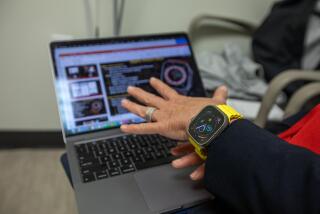Girl, 11, With Pacemaker Is Just ‘Perfect’
- Share via
When Andrea Montano begins junior high school Monday, it will be as exciting as it is for every kid stepping into the world of homework and boyfriends. It also will be something of a minor miracle.
The 11-year-old Santa Ana girl was born with a series of congenital heart defects, each considered significant enough to kill her. She has been through major surgery five times, including a heart reconstruction at the age of 8.
But on Aug. 5, Andrea was among the first in the nation to receive a state-of-the-art pacemaker, which was implanted in her abdomen and connected to her heart. It was the first such implant on a child in Orange County.
Should Andrea’s heart skip a beat, the pacemaker will kick in to regulate it. The pacemaker also will allow a normal life for a girl who almost didn’t make it past infancy.
Monday, less than a month after the surgery, Andrea and her Welsh mountain pony took
first place in Norco’s Labor day Parade for their Indian costumes.
“‘I’m feeling pretty good now. Well, perfect,” said Andrea, whose mother describes her as “full of a drive to live.”
The Activitrax pacemaker is unique in its ability to sense the level of physical exertion of the wearer and increase the heart rate accordingly. Conventional pacemakers are set at a constant heart rate between 60 and 80.
Stimulates Heart
The $4,800 Medtronic Inc. device, which was approved by the U.S. Food and Drug Administration in June, is capable of delivering electrical impulses to stimulate contractions of the heart at rates between 60 and 150 beats per minute.
The variable rate provides an attractive alternative, especially for children, to the conventional device, which restricts most strenuous physical activity.
Now the only reminders of Andrea’s medically troubled childhood will be a weekly telephone check with Medtronic technicians in New York.
Once a week, Andrea pulls a Cardiocare unit from the closet, attaches impulse-transmitting wires around each wrist, puts a magnet up to her abdomen and sets the phone receiver in a computer modem.
With that simple procedure, a Medtronic team is able to monitor the function of the electronic pacemaker. If a problem is detected, the Medtronic technicians will notify Andrea’s doctor. Or, if necessary, a Medtronic field representative will visit Andrea at her home and electronically re-program the pacemaker.
Andrea’s multiple heart defects were diagnosed at three weeks. At the ages of 1 and 5, she underwent operations in which surgeons removed the main arteries from both arms and used them in her chest.
Weak Pulse
Since then, Andrea has been without an easily discernible pulse at her wrists, a condition that has confused unsuspecting paramedics and medical interns. When Andrea was 8, Dr. Alan B. Gazzaniga opened Andrea’s chest to perform surgery and found it would be impossible.
Andrea’s mother, Nora Montana, recalled: “He told me, ‘I can close her up and you can have your daughter back alive’ ” but with limited ability or he could try a more experimental procedure.
“Knowing Andrea, I just had to say, ‘Do it.’ She went into the surgery expecting great things. She wanted to be able to do things like other kids.”
The operation made it possible for blood to bypass the damaged right ventricle.
At that time, wires for a pacemaker were also implanted, coiling down to a tiny box in Andrea’s abdomen, so that should a pacemaker ever be needed, it would not be necessary to reopen her heart.
Soon she was riding bikes and roller-skating again.
Last June, however, Andrea’s mother began noticing “symptoms of slowing down again.”
A massive fluid buildup threatened to collapse the heart. Andrea was rushed to the hospital and again underwent surgery. Doctors suspected the pacemaker wires might have been causing an irritation, allowing the fluid to fill the organ sac. So the wires connecting Andrea’s heart to the potential pacemaker site in her abdomen were snipped.
She went back to school, but her problems were hardly over. She suffered episodes of unconsciousness and missed more days of school than she attended.
More Surgery
In February, doctors determined that the irregular heartbeat was causing the problem. That was when Gazzaniga told the Montanos that he probably would have to implant a pacemaker to regulate her heart. Again she underwent surgery, and again she returned to school.
But this time, she began coming home with stomachaches. And she had trouble falling asleep.
One evening in early June, Andrea began vomiting blood. That night, Nora Montano said, she heard an unusual fear in her daughter’s voice. “She was really scared and crying and asked: ‘What’s the matter with me? Am I going to die?’ ”
She was admitted to the intensive care unit of St. Joseph Hospital in Orange and diagnosed as suffering from a ruptured peptic ulcer. It was then that Andrea’s cardiologist, Dr. Donald R. Sperling, told her mother about the new Activitrax pacemaker.
Minutes after he explained the device to her, she went to the hospital cafeteria and saw a newspaper article about the pacemaker, which the FDA had approved only that week. “It was amazing how the timing was so right,” she said.
Ironically, the implant would mean reopening Andrea’s heart, which would not have been necessary if the wires had not been cut only months before.
As soon as Andrea had recovered from the ulcer, the implant was made.
Gazzaniga, whom Andrea calls Dr. Gizmo, says she now has a normal life expectancy.
Despite her lost time from school, Andrea will start Carr Junior High School in Santa Ana with her class because her test scores have been high.
She is, Gazzaniga said, “very lucky.”
More to Read
Sign up for Essential California
The most important California stories and recommendations in your inbox every morning.
You may occasionally receive promotional content from the Los Angeles Times.













